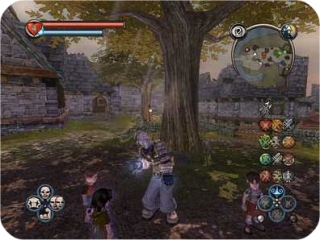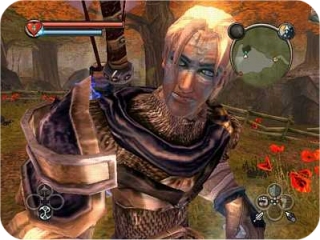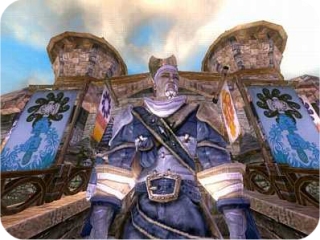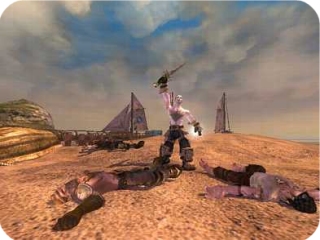| OVERALL | 4.5 | | GRAPHICS | 4.5 | | CONTROL | 4.0 | | MUSIC/FX | 5.0 | | VALUE | 3.5 |
Peter Molyneux’s Opus. That’s the other title for Fable, the open ended Xbox RPG/Adventure that began life as Project Ego so many years ago. Like any good tale worth telling, the concept of Fable took on a life of its own. Rumors of fantastic gameplay advances scooted around the net, press releases hyping never before seen innovations sent goosebumps throughout the adventure community and Xbox owners everywhere gloated that Fable was all theirs and theirs alone. Now that Fable is set for release any moment now and I’ve personally had the experience of playing the game from beginning to end, it’s time to unravel the fairy tale and see it for what it is: a well oiled adventure game that will more than satisfy gamers raised on Link, but will alienate RPG purists. Having to reel in and cut various gameplay advances such as the online aspect, Molyneux and his team had the unenviable task of reducing the scope of their project so that it would not only meet this Fall’s release date but so that it would be actually be completed in this life time. Having to do so, undoubtedly broke the heart of the team because having spoken with some of them in the past, Fable was to be the “be all and end all” of adventure games. Had they been afforded the luxury of another fice years of development time, I can assure you that they might have succeeded in creating such an ambitious product. The end result however, is far from spectacular but highly engrossing and playable, which is really what matters most.  When Fable was in the early stages of development the concept regarding consequences of the players actions was a brilliant novelty although some had forgotten at the time that Molyneux’s most recent project, Black and White, featured this at the core of its gameplay. As well, during the production cycle of Fable, Star Wars: Knights of the Old Republic was developed and released and featured the choices between good and evil that players could alternate between throughout the game. Fable hoped to take this to the next level and for the most part, mission accomplished. Players reputations will precede them in Fable, depending on if they choose a moral or unjust path. This is perhaps Fable’s saving grace and reason to keep playing as your character matures over the game years while the story unfolds. When Fable was in the early stages of development the concept regarding consequences of the players actions was a brilliant novelty although some had forgotten at the time that Molyneux’s most recent project, Black and White, featured this at the core of its gameplay. As well, during the production cycle of Fable, Star Wars: Knights of the Old Republic was developed and released and featured the choices between good and evil that players could alternate between throughout the game. Fable hoped to take this to the next level and for the most part, mission accomplished. Players reputations will precede them in Fable, depending on if they choose a moral or unjust path. This is perhaps Fable’s saving grace and reason to keep playing as your character matures over the game years while the story unfolds.
You begin the game as a child and are introduced to Fable’s combat system and the morality concept through an entry level sequence involving earning enough money to buy a birthday present for your sister. How you go about this task is up to you – you can be a good boy or a bad ass – and I found it instantly intoxicating. Unfortunately once you get into the meat of the game you’ll discover as I did, that situations involving such moral dilemnas aren’t quite as interesting as you thought they’d be although by cosmetic appearances alone, the system appears to be quite involved. After a cataclysmic event early in the game, the player is taken to the Heros Guild where further training is undertaken to become the brave adventurer you are desitined to become. Or not. At the Guild you will learn the nuances and controls of the various attacks such as melee (close proximity to your foe), long range and magic. I spent a lot of time practicing and honing my long range attacks only to discover while playing through the game that it wasn’t entirely neccesary. Melee attacks and magic can almost handle anything the game throws at you, aside from a few flying enemies that will require the use of archery. Fighting controls in Fable are entirely real time, much like Nintendo’s The Legend of Zelda games and RPG purists may not enjoy this aspect, preferring the traditional turn based combat of the Final Fantasy series.  Mastering the various controls of the game is a feat in itself at first. I would suggest familiarizing yourself with the magic system first and foremost as it’s not entirely intuitive due to the number of buttons you’ll cycle through once you amass a half dozen spells or more. Truth be told you’ll struggle more with becoming comfortable with the controls in Fable more than you will actual foes. For the most part, the enemies in Fable don’t require a lot of thought to defeat even though their AI can be particularly impressive as they often switch tactics depending on your proximity to them. If you’re far away you can expect them to greet you with long range arrow attacks, but get considerably closer and they’ll greet you will razor sharp swords or eye gouging maces. They will also do their best to surround you. And yet, it’s not as problematic as it sounds thanks in part to the ever appearing health pickups and resurrection vials which make death nothing more than a slight hiccup on the road to victory. Mastering the various controls of the game is a feat in itself at first. I would suggest familiarizing yourself with the magic system first and foremost as it’s not entirely intuitive due to the number of buttons you’ll cycle through once you amass a half dozen spells or more. Truth be told you’ll struggle more with becoming comfortable with the controls in Fable more than you will actual foes. For the most part, the enemies in Fable don’t require a lot of thought to defeat even though their AI can be particularly impressive as they often switch tactics depending on your proximity to them. If you’re far away you can expect them to greet you with long range arrow attacks, but get considerably closer and they’ll greet you will razor sharp swords or eye gouging maces. They will also do their best to surround you. And yet, it’s not as problematic as it sounds thanks in part to the ever appearing health pickups and resurrection vials which make death nothing more than a slight hiccup on the road to victory.
As you progress into adulthood where the majority of Fable takes place, you’ll begin to see exactly how the game is put together and how the cause and effect style of gameplay isn’t as free as you had hoped. One of the games biggest downfalls in my opinion is how your character is able to simply purchase his way out of his “evil or good” lifestyle by making a donation to the God of his choice. What was the point of acting poorly or saintly if this “get out of jail free” card exists? What will most likely thrill gamers is the cosmetic changes that occur depending on your characters moral choices. If you act bad, expect to look the part and if you’re a goody two shoes long enough you’ll actually glow with a halo like intensity. NPCs will also react to you differently depending on your social standing and often times your reputation will precede you when you enter a town. Your actions will also sometimes net you a label or title, which you may be referred as by NPCs. For a game that touts freedom as much as Fable does, I was completely surprised that certain quests I failed were available for me to begin again anew. I was expecting that if I screwed up, I would move on with my characters life and not have to repeat an event. Unfortunately this is not the case and I have to say it was jarring and really clashed with the concept of openended gameplay. Most quests aren’t particularly difficult and once or twice through will usually do the trick. Rarely did I have to restart a quest more than three times.  As the epic story progressed I actually felf myself feeling less and less part of the overall experience and I think I finally pinpointed why. The story while epic in nature, doesn’t seem to take itself too seriously. There are too many lighthearted moments that are completey incongruent with the mood of the story at the time. As well your character is completely devoid of any personality, aside from the actions you allow him to perform which shape his cosmetic appearance and reputation, I never felt any sort of connection to him or to other NPCs I encountered. Where the Final Fantasy games instantly draw you in with characters and events that seem impossibly emotional for a mere videogame, Fable keeps the player at arms length and therefore my emotional investment to the characters was almost nil even after I had been playing for a dozen hours. As the epic story progressed I actually felf myself feeling less and less part of the overall experience and I think I finally pinpointed why. The story while epic in nature, doesn’t seem to take itself too seriously. There are too many lighthearted moments that are completey incongruent with the mood of the story at the time. As well your character is completely devoid of any personality, aside from the actions you allow him to perform which shape his cosmetic appearance and reputation, I never felt any sort of connection to him or to other NPCs I encountered. Where the Final Fantasy games instantly draw you in with characters and events that seem impossibly emotional for a mere videogame, Fable keeps the player at arms length and therefore my emotional investment to the characters was almost nil even after I had been playing for a dozen hours.
From an artistic perspective Fable packs a punch. The gameworld is lush and brilliantly lit, filled with minute details that never fail to impress. Throughout your adventure you’ll travel the usual roads of such adventures and find yourself in a dark forests, swamps, cemeteries and of course, dungeons and caves. There is a price to pay for this attention to detail and it comes in the form of long load times that unfortunately rip the player out of experience while the next area loads. If the game had been loaded onto the hard drive this would have cut down on the times considerably which begs the question: “So what is the Xbox hard drive for anyway?” The voice acting and orchestral soundtrack is brilliant and lends the utmost quality to the production. While the game can be lighthearted at inopportune times, I didn’t hear any music or sound effects that made we want to turn the game off. Had this been developed in Japan I fear that the soundtrack would have been rife with what I call that cheesy “Sonic The Hedgehog” distoted guitar when the game leapt into an action sequence. Shudder….  Fables developers have been promoting the games endless playtime, allowing for hours upon hours of exploration even after the story is finished. While that’s true to an extent once you get further into the game you’ll see that going back and starting the game all over again isn’t entirely necessary as you’ve figured out all the tricks. Even such revolutionary ideas as marriage and divorce end up being more exciting in theory than they are in execution. All told, you might be able to wring a good 30 hours out of Fable and that’s exploring every last inch of it, which I don’t have to tell isn’t exactly “epic” in terms of game time when it comes to an adventure this hyped. Personally I think you’ll get the most of out Fable if you clock in around 15 – 20 hours as the gameplay still has some surprises and magic in it at that point in time. Play it much past the end of the game and you run the risk of Fable wearing out its welcome as that is when the seams begin to show and you realize the Wuzard is just a guy behind a curtain. Fables developers have been promoting the games endless playtime, allowing for hours upon hours of exploration even after the story is finished. While that’s true to an extent once you get further into the game you’ll see that going back and starting the game all over again isn’t entirely necessary as you’ve figured out all the tricks. Even such revolutionary ideas as marriage and divorce end up being more exciting in theory than they are in execution. All told, you might be able to wring a good 30 hours out of Fable and that’s exploring every last inch of it, which I don’t have to tell isn’t exactly “epic” in terms of game time when it comes to an adventure this hyped. Personally I think you’ll get the most of out Fable if you clock in around 15 – 20 hours as the gameplay still has some surprises and magic in it at that point in time. Play it much past the end of the game and you run the risk of Fable wearing out its welcome as that is when the seams begin to show and you realize the Wuzard is just a guy behind a curtain.
If you’ve been anxiously awaiting Fable to hit your local Wal-Mart, by all means pick up a copy and have at it. It’s one of those rare titles that players will have decidely different experiences with it. Some will fill in the holes with their imaginations while others will be nitpicking every hiccup in continuity along the way. Ultimately it’s how you play this game that will have the most effect on how much you enjoy it. | 
